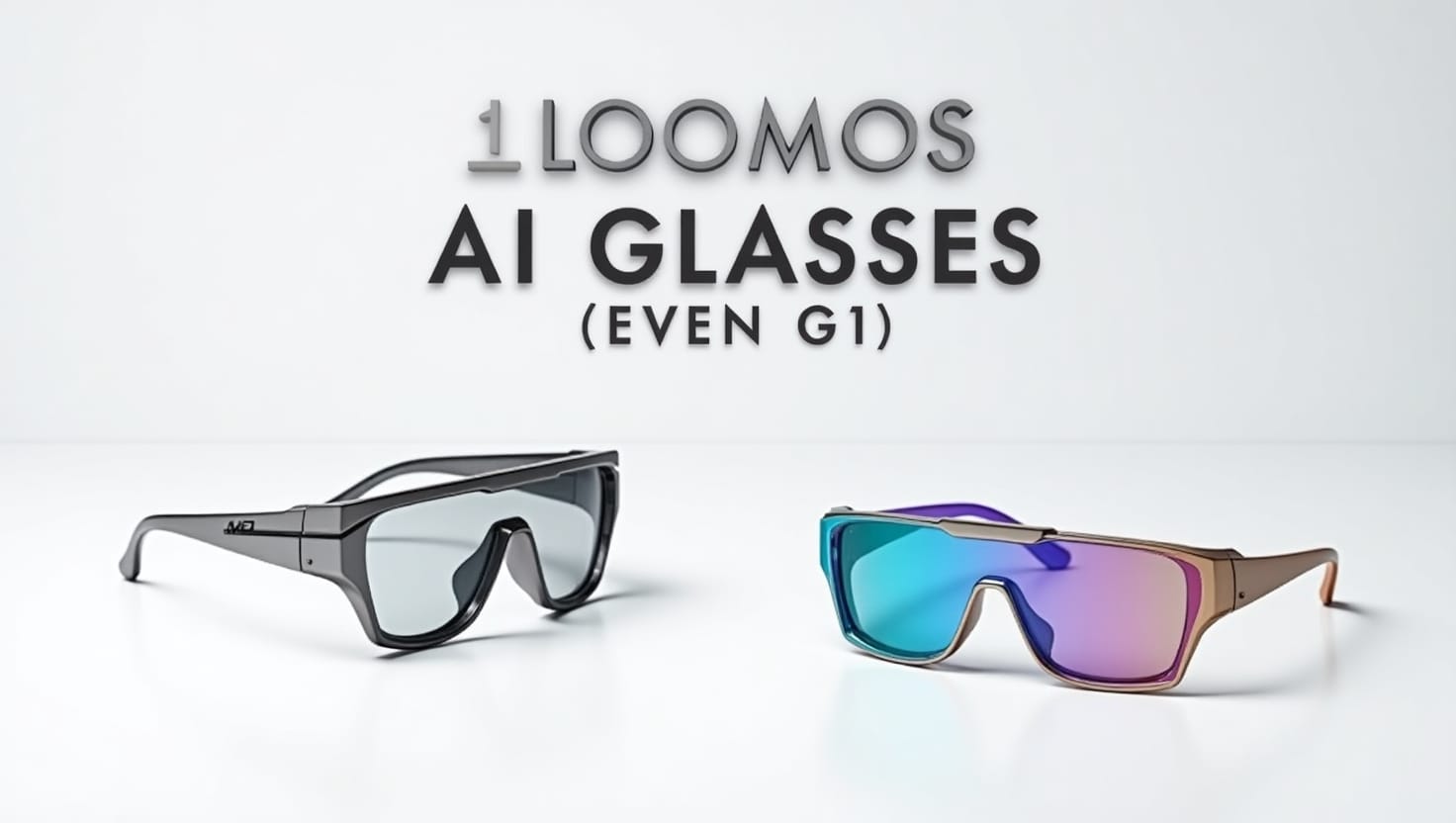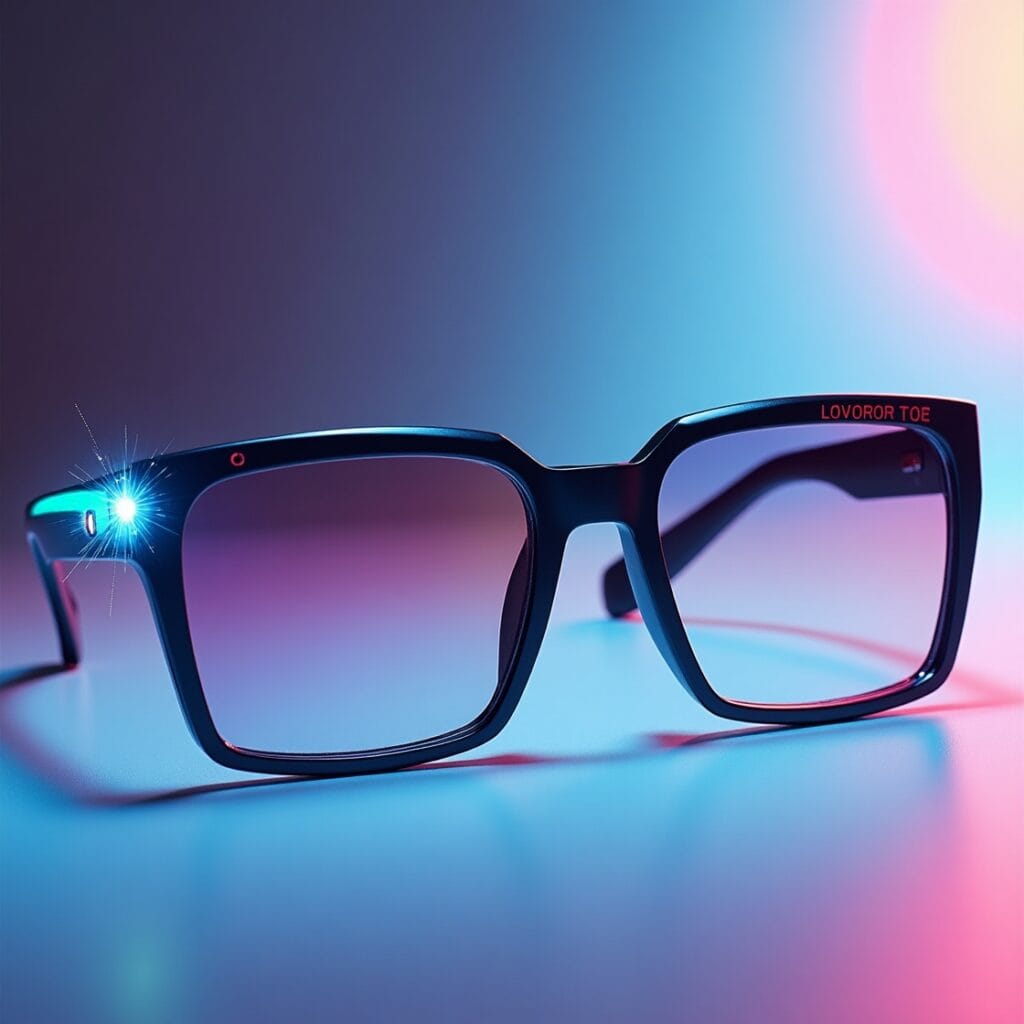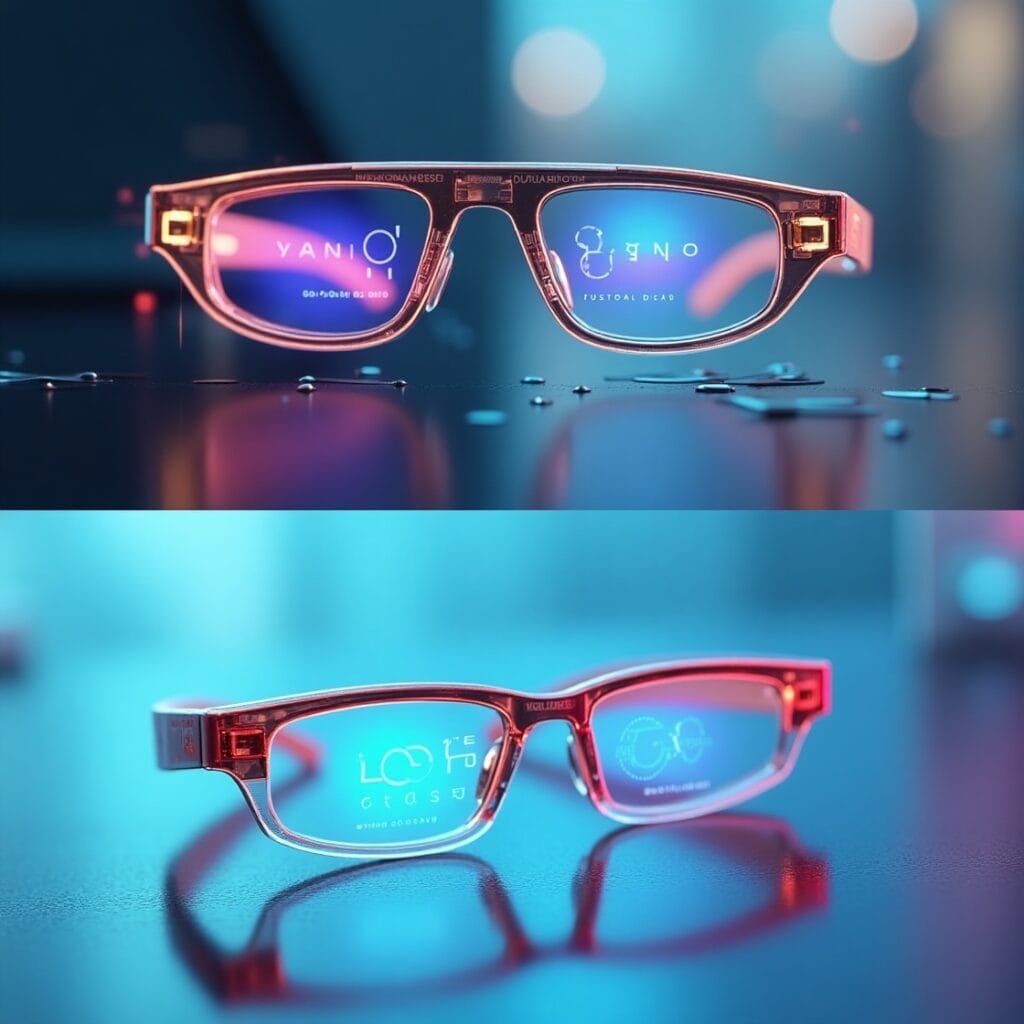
Stylish design meets cutting-edge AI and AR – Are these the smartest glasses of 2025?
The future of wearable tech is here, and it’s not a watch. In 2025, AI-powered smart glasses are set to become the next big revolution — and leading the way are the Loomos AI Glasses and the Even G1 Smart Glasses.
These futuristic wearables combine Augmented Reality (AR) with built-in AI assistants, offering a hands-free, screen-free, yet fully connected experience.
🔍 Loomos AI Glasses – Sleek, Minimal, and Smart
The Loomos AI Glasses are designed for simplicity and performance. This lightweight, minimalist wearable is packed with powerful AI features.
⭐ Key Features:
- Built-in AI Assistant: Navigate, translate, search, and get information hands-free using voice.
- AR Visual Overlays: See navigation, notifications, and contextual data directly in your field of view.
- Voice & Touch Controls: Easy interaction with just your voice or light touch on the frame.
- Lightweight & Stylish: Designed for comfort and long-term daily wear — all while looking great.
📸 Use-case example: Imagine walking through a city while your glasses show you live navigation or translate foreign signs — all without pulling out your phone.

Explore it on :- Loomos AI Glasses
🤖 Even G1 Smart Glasses – High-Tech Meets High Fashion
The Even G1 Smart Glasses are designed for both function and fashion. They take AR eyewear to the next level with rich features and premium style.
🚀 Standout Features:
- Full AR Vision Display: Display text, data, health stats, and more in real-time.
- Health & Wellness Tracking: Monitor heart rate, posture, step count, and even concentration.
- Gesture Controls: Interact with your glasses using head movements and subtle gestures.
- AI Productivity Assistant: Set reminders, check weather, manage your schedule, and get intelligent suggestions throughout your day.
- Interchangeable Frames: Switch styles without switching tech — stay fashionable.

🧠 AI + AR = The Smartest Everyday Companion
Both Loomos and Even G1 aim to eliminate your need to look at your phone 100+ times a day by putting intelligence directly into your line of sight.
You can expect:
- Real-time language translation
- AR search overlays
- Smart notifications
- Voice-guided tasks
- Seamless hands-free navigation
All from a small, stylish device you wear on your face.
📅 Launch Timeline & Pricing (Expected)
| Feature | Loomos AI Glasses | Even G1 Smart Glasses |
|---|---|---|
| Expected Launch Date | Q4 2025 | Q4 2025 |
| Estimated Price | $349 – $499 | $399 – $599 |
| Compatibility | iOS & Android | iOS, Android, and Desktop Sync |
| Battery Life | Up to 10 hours | 8 to 12 hours (depending on usage) |
| Connectivity | Bluetooth, Wi-Fi | Bluetooth, Wi-Fi, Cloud Sync |
Note: Final specifications and pricing will be confirmed at official product launches.
The Real-World Impact of Smart Eyewear
While Loomos AI Glasses and Even G1 are packed with futuristic features, their real strength lies in how seamlessly they integrate into daily life. Imagine walking into a grocery store where your glasses instantly recognize products, suggest healthier alternatives, or even display real-time discounts. For students, these glasses can act like an on-demand tutor—translating complex terms, recording lectures, and even highlighting important notes right in their field of vision.
The biggest game-changer here is accessibility. For visually impaired users, Loomos and Even G1 can provide voice-guided navigation, object detection, and instant text-to-speech. This makes them not just a luxury gadget, but a life-changing assistive tool.
Style Meets Functionality
In the past, smart glasses struggled with bulky designs and awkward looks. But with Loomos AI Glasses and Even G1, the narrative has shifted. These devices blend sleek aesthetics with cutting-edge tech, making them look like high-end fashion accessories rather than clunky gadgets. This design-first approach ensures users won’t feel out of place wearing them in professional settings, social events, or even casual hangouts.
Competitive Edge in the Smart Wearables Market
Unlike traditional AR headsets or VR goggles, Loomos AI Glasses and Even G1 focus on lightweight usability. They don’t try to replace your smartphone entirely; instead, they enhance it by offering quick, glance-based information access. This competitive positioning makes them more appealing for everyday adoption compared to bulkier competitors like Meta Quest or Apple Vision Pro, which are better suited for immersive experiences.
AI at the Core of Smart Eyewear
What sets Loomos AI Glasses and Even G1 apart is their deep AI integration. These aren’t just glasses with a display—they act as a personalized digital assistant. With natural language processing, they can answer questions, summarize news in real time, or even translate foreign conversations instantly. The AI learns user behavior, meaning the longer you wear them, the more personalized and intuitive the experience becomes.
For example, if you often attend meetings, the glasses can auto-generate meeting notes and even highlight action points. If you’re traveling, they can serve as a tour guide, identifying landmarks and giving historical context—something no traditional wearable currently offers at this scale.
Battery & Connectivity Innovation
One of the biggest pain points for past smart glasses was poor battery performance. Loomos and Even G1 have tackled this with energy-efficient processors and smart power management, ensuring users get an all-day experience without constantly reaching for a charger.
Connectivity also plays a huge role. With support for 5G, Wi-Fi 6, and Bluetooth LE, these glasses ensure lag-free streaming, faster updates, and seamless syncing with other devices like smartphones, laptops, or even smart home ecosystems.
The Social Factor – Changing the Way We Interact
Perhaps the most underrated aspect of Loomos AI Glasses and Even G1 is their potential to redefine human interaction. In professional networking events, they can instantly display someone’s LinkedIn profile, past conversations, or shared interests—making introductions smoother. For language barriers, real-time subtitles can appear directly in your vision, allowing for borderless communication.
This hints at a future where glasses are not just tools but bridges, connecting people across cultures and professions more effortlessly than ever.
The Next Era of Everyday Technology
Smartphones changed how we connect, smartwatches changed how we track our health, and now smart eyewear is set to change how we see the world. Loomos AI Glasses and Even G1 are not just another pair of wearable gadgets—they represent a massive leap toward human-centered computing. The vision is clear: technology that feels less like a device and more like a natural extension of our senses.
What makes these glasses so exciting is not just the features on paper, but the way they merge augmented intelligence, design, and real-world usability. Instead of trying to overwhelm users with hundreds of apps, they focus on streamlined, practical enhancements that make everyday life smoother.
Beyond Notifications: A Smarter Way to Access Information
In earlier versions of smart glasses, notifications were the headline feature. But let’s be honest—no one wants another gadget buzzing every two minutes. Loomos AI Glasses and Even G1 move past that problem by prioritizing contextual, glance-based information.
Imagine walking down a busy street. Instead of pulling out your phone, your glasses can:
- Highlight the fastest route to your destination.
- Show ratings of nearby restaurants as you pass them.
- Translate street signs in real time.
- Notify you discreetly if a friend is nearby.
This is information when you need it, not when your device decides to interrupt you.
Personalized AI Assistance
The real star of these smart glasses is AI-driven personalization. Unlike traditional wearables that give the same experience to every user, Loomos and Even G1 learn from your routines. If you’re a fitness enthusiast, the glasses might display live workout stats. If you’re a student, they can highlight key lecture points or provide summaries of research papers. If you’re a traveler, they automatically switch to navigation and translation modes.
It’s like having Siri, Google Assistant, and ChatGPT combined, but built into your vision and tailored to your lifestyle.
Accessibility and Inclusivity: A Silent Revolution
While most tech companies advertise their products as luxury items, Loomos AI Glasses and Even G1 are proving that wearable tech can be life-changing. For people with low vision or visual impairment, these glasses offer:
- Object detection (recognizing obstacles in real time).
- Text-to-speech capabilities (reading books, menus, or signs aloud).
- Voice-guided navigation (helping users walk independently).
This transforms eyewear from a cool gadget into an essential accessibility tool, breaking down barriers for millions of people.
Style Meets Future Tech
One of the biggest reasons earlier smart glasses failed (like Google Glass) was design. They looked awkward, bulky, and “techy”, making people self-conscious in public.
Loomos AI Glasses and Even G1 are rewriting that story. Their sleek, lightweight frames resemble premium sunglasses or prescription eyewear. They are discreet enough for office wear, stylish enough for social outings, and durable enough for travel.
This design-first approach ensures that users won’t feel like they’re wearing a gadget, but a fashion accessory with superpowers.
Seamless Integration with Your Digital World
Another highlight is connectivity. Instead of isolating users into a new ecosystem, Loomos AI Glasses and Even G1 sync effortlessly with smartphones, laptops, smart TVs, and IoT devices. For example:
- While cooking, your glasses can project a recipe guide without needing to touch your phone.
- While working, they can display notifications, emails, and calendars without breaking focus.
- While traveling, they can serve as navigation overlays, removing the need to constantly check your phone.
This ecosystem-first mindset makes them more practical than bulky AR headsets like Meta Quest or Apple Vision Pro, which are amazing for immersive tasks but impractical for all-day use.
Productivity on the Go
For professionals, these glasses could be a game-changer. Imagine being in a meeting where:
- The glasses transcribe everything in real time.
- Key talking points are automatically highlighted.
- Action items are extracted and saved to your to-do list.
For journalists, they can serve as hands-free recording tools. For doctors, they can pull up patient histories during consultations. For engineers, they can overlay design blueprints right on-site.
This is where Loomos and Even G1 cross from being just another gadget to being a productivity powerhouse.
Entertainment and Media in a New Dimension
Entertainment is also being redefined. Instead of staring at a small phone screen, users can project immersive virtual displays right in front of their eyes. Whether it’s watching a movie, playing a game, or browsing social media, the glasses deliver a cinema-like experience in a pocket-sized device.
The Even G1, in particular, focuses on delivering high-quality sound with spatial awareness, ensuring users don’t lose touch with their surroundings while enjoying content. This makes them safer and more practical for real-world use compared to noise-canceling headphones or VR headsets.
Battery, Performance, and Practical Use
Battery life has always been a hurdle for wearable tech. Loomos and Even G1 tackle this with low-power AI chips and optimized display systems, ensuring all-day performance. Advanced wireless charging docks and portable cases make recharging effortless, further removing friction from daily use.
Social Interaction and Human Connection
One of the most fascinating aspects of these smart glasses is how they reshape social interactions. Instead of staring down at a phone during conversations, you can maintain eye contact while discreetly accessing information.
At networking events, the glasses could:
- Recognize faces.
- Display past conversations.
- Show LinkedIn or professional details instantly.
And when crossing language barriers, real-time subtitles make conversations seamless. This could revolutionize global business, travel, and cultural exchange.
The Future of Smart Eyewear
While Loomos AI Glasses and Even G1 are impressive today, their true potential lies in what comes next. Future updates could include:
- AR shopping experiences, where items you look at display pricing and reviews.
- Health monitoring, like real-time heart rate or blood sugar tracking.
- Education tools, projecting 3D interactive models in classrooms.
- Workplace integration, with hands-free dashboards for industries like construction, medicine, and aviation.
We’re entering an era where glasses are not just for vision—they’re for enhanced perception, productivity, and lifestyle.
Final Thoughts
Loomos AI Glasses and Even G1 are more than futuristic gadgets. They represent a shift in how we interact with technology—moving away from screens in our hands to information that lives naturally in our world. By combining AI intelligence, sleek design, and practical features, they’re setting the stage for the mainstream adoption of smart eyewear.
The journey of smartphones and smartwatches shows us one thing: once people experience convenience at this level, there’s no going back. Loomos and Even G1 are the next big leap, and they just might be the devices that finally bring smart glasses into the everyday mainstream.
Are Smart Glasses Finally Mainstream?
AI and AR are becoming more accessible, and smart glasses are now practical, stylish, and incredibly useful. Whether you’re a student, a traveler, a fitness buff, or just someone who wants to reduce screen time, Loomos and Even G1 are exciting options to explore.
- Loomos AI Glasses are perfect for tech minimalists and smart productivity lovers.
- Even G1 Smart Glasses cater to those who want a fashionable yet functional wearable.
Stay Updated with USAtrends.tech
As soon as these smart glasses launch, USAtrends.tech will bring you:
- Full hands-on reviews
- Buying recommendations
- Comparisons with other smart glasses (Meta, Apple Vision, Xreal, etc.)
The wearable revolution is here — and it’s more intelligent than ever.
🧾 Quick Recap:
- Loomos AI Glasses: Lightweight, built-in AI, AR overlays, minimalist design.
- Even G1 Smart Glasses: Stylish, fitness-friendly, full AR vision, gesture controls.
- Launch: Expected late 2025.
- Price: $350 to $600.
Stay tuned for more tech breakthroughs — always updated at USAtrends.tech!




